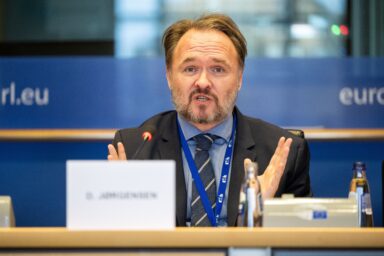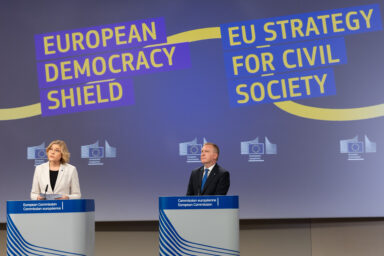A ranking parliamentary health committee member told EU Perspectives that the current negotiations on antimicrobial resistance are a defining test of the European Union’s capacity to lead after years of stagnation.
Forget political symbolism; it is size what matters. When bacteria or viruses develop the ability to survive and grow despite exposure to drugs designed to kill them, investors need incentives “just the right size” to keep new, effective drugs coming, one of the European Parliament’s leading health figures says.
In exclusive remarks to EU Perspectives during the Danish EU Presidency High-level Conference on Antimicrobial Resistance (AMR), MEP Stine Bosse (Renew/DNK) spoke of such incentives. She framed the transferable exclusivity voucher (TEV, a policy incentive mechanism designed to encourage pharmaceutical companies to develop new antibiotics to combat AMR) and the broader incentive framework as more than a technical adjustment. The vice-chair of the European Parliament’s influential Public Health Committee (SANT) sess it as a strategic tipping point for Europe’s global role in antimicrobial innovation.
“This is Europe’s moment to lead, and I believe in Europe. We can become the first region globally to put in place an ambitious framework that creates a real market for novel antimicrobials. After decades of inaction. And if we get it right the first time, we can inspire others to follow as well,” Ms Bosse said. For the Danish member, the decisive issue is not simply how many new antibiotics reach approval. It is whether Europe succeeds in creating a stable innovation engine that can replenish the pipeline continuously.
You might be interested
Pipeline is the key word
“Pipeline is the key word here,” Ms Bosse stressed. “If our European framework is to make a difference, it should deliver more than a few new antimicrobials to the market. It can’t be stop-and-go. It needs to be a constant, always-on pipeline that stimulates new innovation, supports novel antimicrobial development all the way to the market. And also ensures that we have robust governance, using these new drugs in highly targeted ways.”
She underlined that the credibility of the framework will depend less on political symbolism and more on its capacity to give investors confidence over a decade-long horizon. “What’s currently on the table is indeed a combination of the voucher (TEV) and a voluntary subscription model. My key message here is that no matter the exact design of these two policy tools, the whole package needs to be predictable and right-sized.”
Investors and innovators need the long-term confidence to invest in new antimicrobials, the MEP insists. They need to be able to look 10 years ahead. And see a model that can support significant investment decisions today. This, in her view, is exactly what we need to achieve.
Guardrails, or gold-plating?
While MEP Bosse framed the political stakes, speakers across the panel warned that the TEV risks being hollowed out during the final phase of negotiations. Kristine Peers, General Counsel at the European Federation of Pharmaceutical Industries and Associations (EFPIA), underlined that the tool remains in the Pharmaceutical Package, but stressed that its effectiveness is now at risk. “All three institutions have kept the TEV. But there are amendments that could weaken the tool and make it ineffective and inefficient. And that’s what I worry about,” Ms Peers said.
Speakers described the direction of travel as one of progressive tightening driven by cost concerns and fears of overcompensation. The political instinct behind these changes reflects budget sensitivity rather than opposition to the principle of the voucher itself. “I understand where these amendments are coming from, and why,” Ms Peers said. “It’s concerns about overcompensations, concerns about the cost to the healthcare systems. But we should remember that actually the European Commission itself put forward in the design of this TEV guardrails to precisely avoid that it would be too costly.”
She said: “You don’t need to double up gold plates upon gold plates. That’s not going to help, in fact it renders this incentive ineffective, inefficient.” Her message was clear: weakening the TEV would undermine not only this policy cycle, but investor trust for years to come. “Europe should be strengthening this TEV, not diluting it,” Ms Peers insisted. “If they do, it would set us back for years, we’d rather have nothing then.”
Why the voucher cannot stand alone
Across industry, regulators and policymakers, the consensus was that the TEV is an essential pull incentive, but not a complete solution. Ms Peers stressed that sustainability depends on what happens after market authorisation: “There is the novel antimicrobials, but also once they are then on the market, they need to stay there and they need to reach the patients,” the EFPIA counsel said. “For that we need additional complementary access models such as subscription models and revenue guarantee models.”
Europe should be strengthening this TEV not dilute it. If they do, it would set us back for years, we’d rather have nothing then. — Kristine Peers, EFPIA
Marco Cavaleri, Head of Office, Health Threats and Vaccines Strategy, European Medicines Agency (EMA) confirmed the need for structural plurality: “We really need to think about what kind of incentives we can put out. And besides that, I strongly believe that we need also to work on the prescription, subscription type of model, to think about alternatives.”
Together, speakers converged on three non-negotiable design principles. The voucher must be big enough in value and predictable in number to change investor behaviour. It must be clearly targeted at antimicrobials where market failure is greatest. And it must be structurally paired with national access tools. This should include subscription or revenue-guarantee models, so that new antibiotics are both developed and reliably deployed.
A fragile pipeline on the brink
Behind the political urgency lies a stark industrial reality. As Marc Gitzinger, President of BEAM Alliance, made clear, the antibiotic development pipeline is dominated by small and micro-biotechs operating on the edge of survival. “80 percent of these drugs are in the hands of small and micro companies,” he said.
He noted that many of these firms lack even basic financial stability: “These companies, half of them, have not even the financial horizon of one year.” When they collapse, the damage goes far beyond one failed balance sheet: “80 to 90 percent of these people that fail leave the space out of pure frustration.” Even regulatory success, he warned, offers no protection if the business model is broken. “Plazomicin looked to be a good and useful drug… and then it went bankrupt,” Mr Gintzinger pointed out.
Push funders such as CARB‑X, GARDP and the AMR Action Fund are currently sustaining several projects. But the conference panellists agreed this model is fundamentally precarious without a credible pull incentive to carry products through to commercial viability.
Affordability safeguards
Patient organisations strongly supported innovation, but not at the expense of equity. The European Patients’ Forum (EPF) warned that transferable exclusivity vouchers risk distorting access if poorly designed. As one representative put it, mechanisms must not “increase costs for health systems and delay access to generics and biosimilars.”
The EPF called for clear conditions, strict limits and transparency safeguards to ensure that innovation does not undermine affordability. They stressed that the right antibiotics must reach patients “wherever they are, no exceptions”.
We can become the first region globally to put in place an ambitious framework that creates a real market for novel antimicrobials. — MEP Stine Bosse (Renew/DNK)
The prevailing message was stark: Europe is operating in a narrow window. Political symbolism without scale would fail to shift market behaviour. Ms Bosse noted that proposals to cap the mechanism at just five vouchers over 15 years “will not provide certainty for investors given they have to make decisions on a 10-year timeline.”
A one-shot opportunity
She said that “the most important test will be ensuring that the voucher overall is right in size. No matter the specific design, the total volume of incentives needs to be big enough for antibiotics to overcome the hurdles and make it work.”
As panellists repeatedly underlined, this is not merely a technical correction to pharmaceutical law, but a credibility test for Europe’s capacity to turn policy into functioning industrial architecture. Failure, they warned, would leave Europe returning within years for legislative repair, having already lost a decade of time, talent and trust.
If this framework gets it right, MEP Bosse argued, Europe does more than fix its own antimicrobial crisis. It sets the global standard for how to rebuild antibiotic markets in the 21st century.










